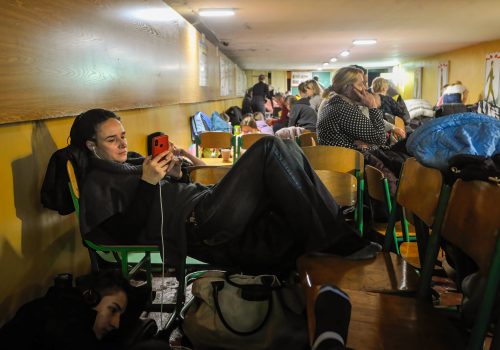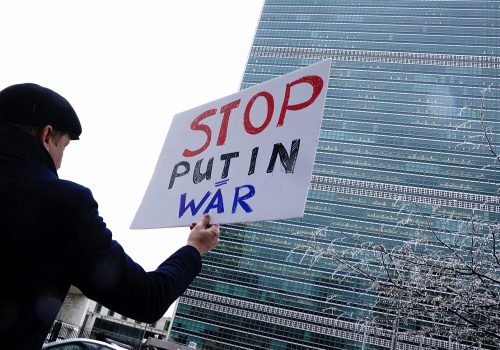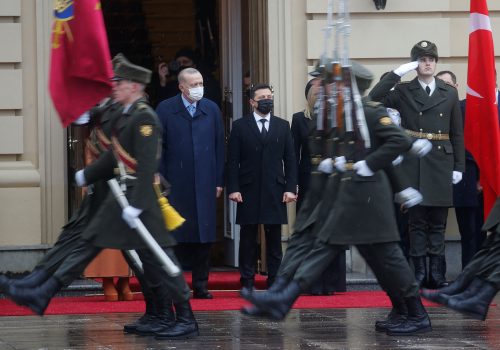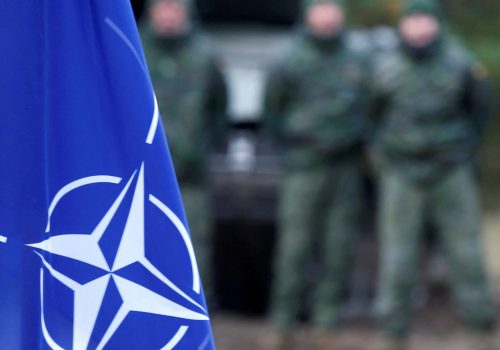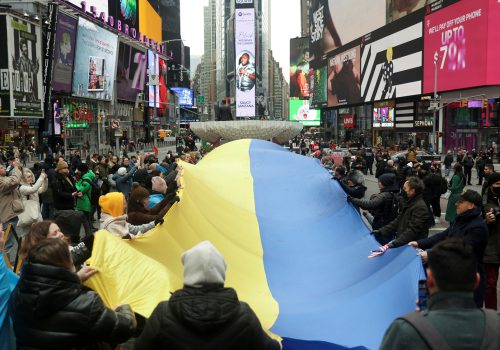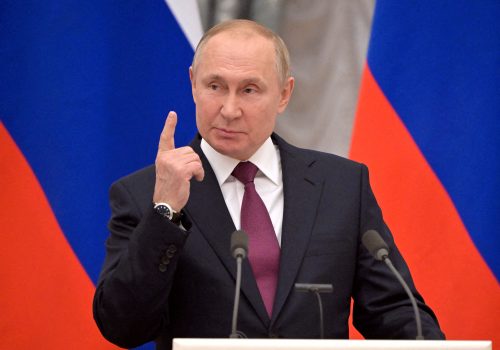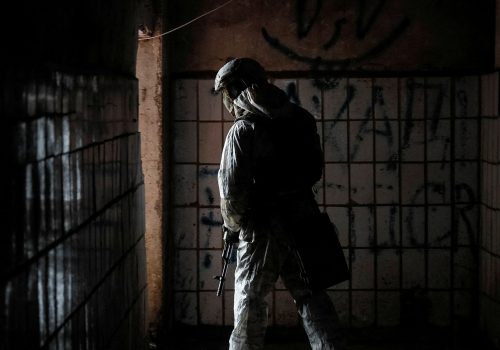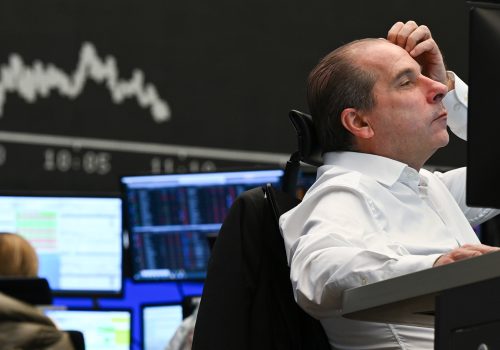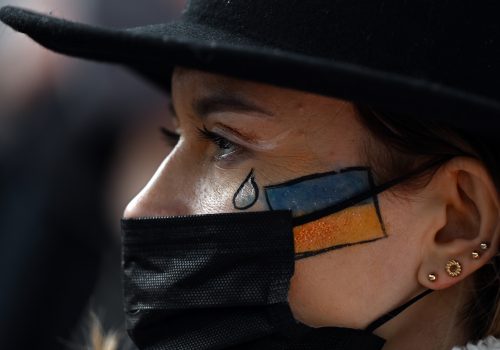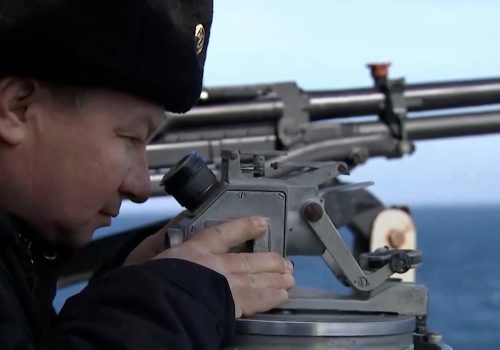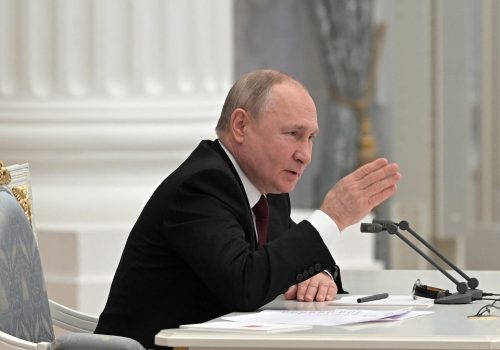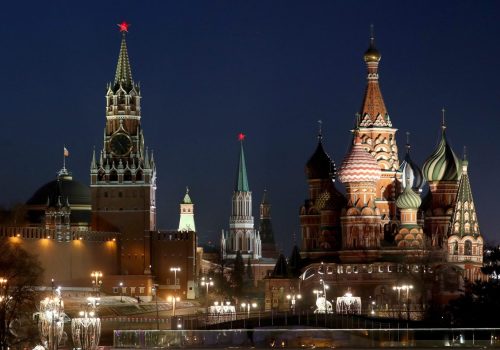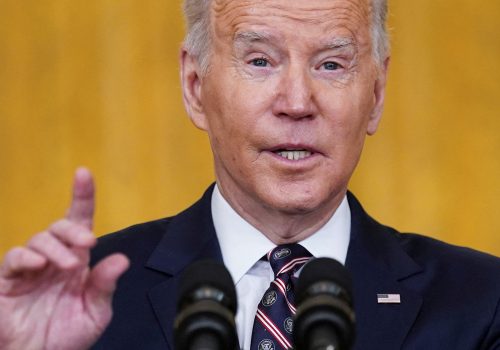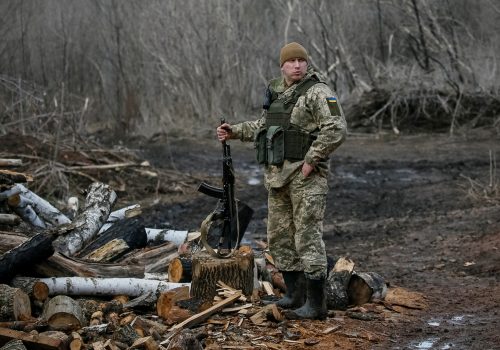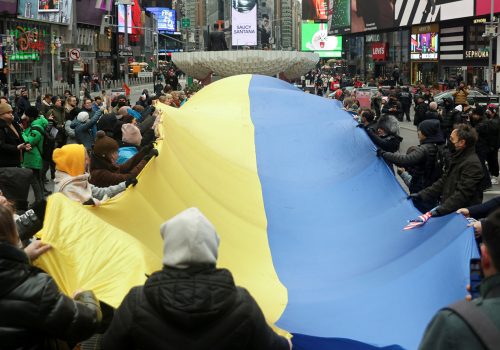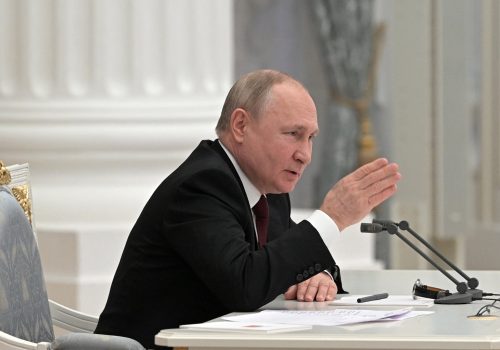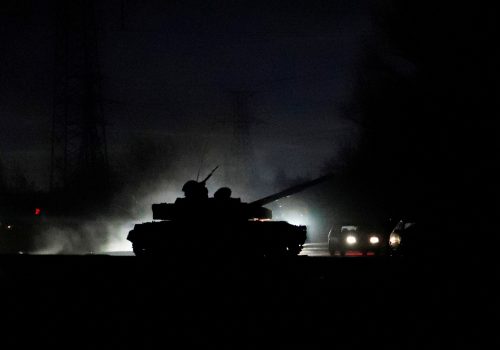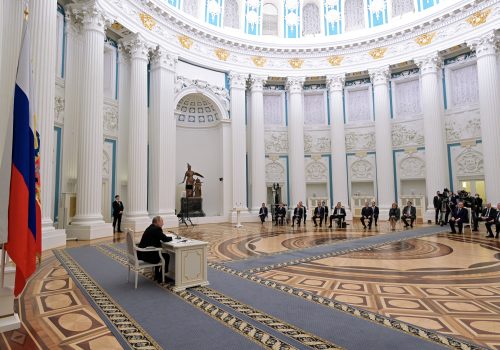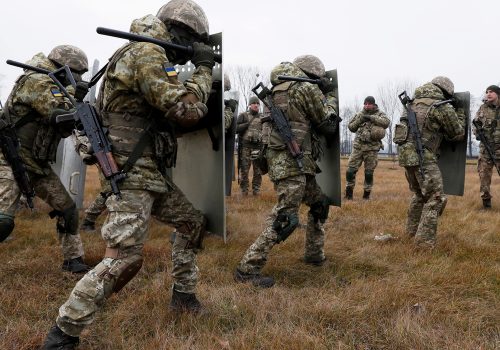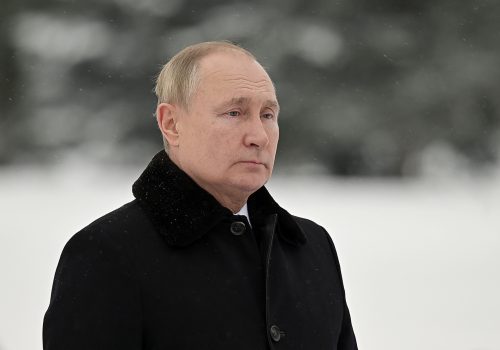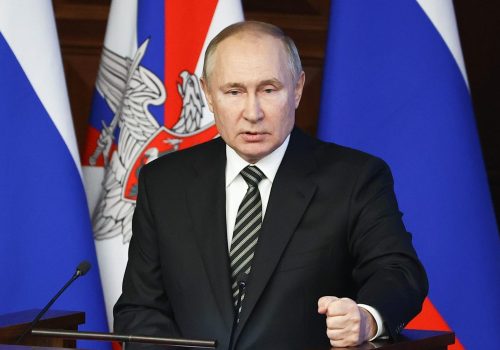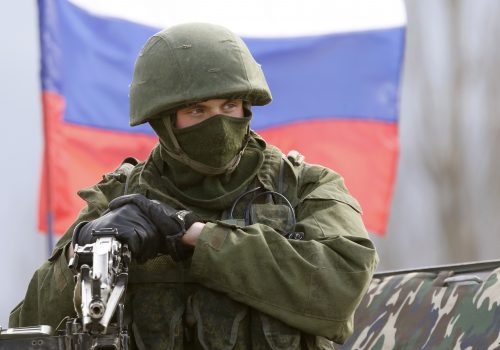LIVE: Russia-Ukraine peace talks, Putin’s nuclear threat, and Germany’s big military bet
As Russia further escalates its military intervention in Ukraine—and with the future of European security and the post-Cold War international order at stake—check back here for the latest insights, analysis, and reporting from the Atlantic Council’s experts as events unfold.
Our latest expert insight and intel:
- Russia-Ukraine peace talks, Putin’s nuclear threat, and Germany’s big military bet
- The West brings down the hammer on the Russian economy
- Ukrainians are wondering: Where is the West?
- Kremlin media used claims of Ukraine creating a dirty bomb to justify invasion
- Polish social media accounts revive anti-Ukrainian sentiments
- View from Kyiv: Trying to sleep under assault
- Mexican YouTube channels claim the US will invade Mexico in response to the Russian invasion
- The effects of this war will be felt far beyond Europe—including in Latin America
FEBRUARY 27, 2022 | 9:50 AM WASHINGTON, 4:50 PM KYIV
Russia-Ukraine peace talks, Putin’s nuclear threat, and Germany’s big military bet
Our experts are closely following three major stories breaking on Sunday.
First, Ukraine and Russia are set to hold peace talks today along Ukraine’s border with Belarus, according to Ukrainian President Volodymyr Zelenskyy.
Second, Russian President Vladimir Putin has placed nuclear forces on high alert. Lt. Col. Tyson Wetzel, the Scowcroft Center’s US Air Force military fellow, gave his personal view on what it says about Russian policy.
Meanwhile, Daniel Fried, the Council’s Weiser family distinguished fellow and former US Ambassador to Poland, offered thoughts on how the United States should respond.
Third, Germany agreed to invest another one hundred billion euros on its military, bringing its defense spending above 2 percent of gross domestic product, in line with NATO targets and an area in which Germany has long lagged. Combined with Berlin’s reversal on the Nord Stream 2 pipeline this week, Europe Center nonresident senior fellow Rachel Rizzo took stock of a whirlwind week for German foreign policy.
FEBRUARY 26, 2022 | 10:37 PM WASHINGTON, 5:37 AM KYIV
The West brings down the hammer on the Russian economy
Share this entry by copying this link.
On Saturday night, the Group of Seven (G7) nations announced a new suite of punishing economic measures against Russia for its war in Ukraine, including removing key Russian banks from the SWIFT international messaging system and imposing new restrictions on the Russian Central Bank’s ability to deploy its international reserves.
Our economic statecraft experts weighed in on what these new measures will mean for the the Russian economy—and how Putin will retaliate.
‘Fortress Russia’ will crumble
SWIFT will get a lot of the immediate press from today’s announcement, but the true hammer blow is the immobilization of Russia’s foreign-exchange reserves. Moscow has for months downplayed the threat of sanctions by pointing to its massive, $630 billion stash of foreign reserves as sufficient to weather the sanctions storm. They have even called it Fortress Russia. Well, in one fell swoop, Fortress Russia is no more, and the Russian economy will pay the price. This is an action truly without precedent in the economic world and will have dire consequences for the ruble, inflation, and just about all other Russian economic indicators.
Will it save Ukraine? I fear not and hope I am wrong. But this is the major step that makes Russia’s economy a pariah alongside its president. While the major Western economies are taking this action, it is worth noting that this could not have happened without the bravery of the Ukrainian people in standing up to the Russian army and President Volodymyr Zelenskyy, who has rallied leaders often sympathetic to Moscow to his cause. Their bravery and skill in forestalling Moscow’s massive military advantage has bought the political space for Western nations to pull together and impose these costs on Russia knowing full well that there will be spillover to their own economies still recovering from the pandemic.
—Brian O’Toole is a nonresident senior fellow at the Council’s GeoEconomics Center and former US Treasury Department official.
An unprecedented step, with global ramifications
The G7 has done something it has never done before—frozen the assets of a G20 member. Sanctioning the Russian Central Bank was considered a remote possibility by senior US officials only a week ago. Today, hundreds of billions of dollars and euros will remain untouchable. To put that in perspective, the amount of money that is now outside of Vladimir Putin’s grasp is the size of Austria’s entire economy.
There is one thing these sanctions cannot touch—gold. Through its massive gold reserves held in Moscow (estimated at $140 billion), the central bank may be able to avoid a total collapse. But it can no longer serve as a backstop to the Russian financial system. That means all the commercial banks now under heavy sanctions could fail.
We should be clear-eyed about what that means. A collapsing ruble, soaring inflation, bank runs, and food shortages—and that is just in Russia. There will be global ramifications including market drawdowns and higher energy prices. But the world’s leading economies decided today that it was a price worth paying. Europe will bear the heaviest load here. And it was their commitment today that put this over the finish line. The unity, and the fact that the heart of Russia’s wealth was frozen, is something that will surprise Putin and his entire inner circle.
—Josh Lipsky is the director of the GeoEconomics Center and former advisor at the International Monetary Fund.
Taking on the oligarchs at last
“Oh by the way… also the oligarchs.” We’ve heard that before. Russian financial networks are always part of this conversation, but quickly set aside as a “nice to have,” because while the concept of Russian dark money sounds sexy, the world behind it is anything but. This is painstaking work taking full bureaucratic power, from law enforcement to financial regulation to intelligence to the prosecutors at the Department of Justice. It takes time, fine print, and regulation over years. And most importantly, it can be a chicken-and-egg problem—where do we start, and how does this rack and stack with drug trafficking or terrorist financing? The priority needs to come from the top: THIS, this financial defense is a priority for US foreign policy in the same way the United States supports territorial defense. The Biden administration has now shown its intentions to make this happen.
My colleagues speak here of the unprecedented measures that the United States and its allies are taking to isolate Russia from the international financial system to “vaporize” the holdings of the Russian state. Taking on the state includes tracing down and freezing the assets of oligarchs. Their assets do not lie on the books of the Russian Central Bank or Russia’s economy—but that is where they belong, to the tune of one trillion dollars stowed away overseas. The West needs to unwind the financial networks that support Putin and those around him, those who pilfer the assets of the Russian state and the Russian people for personal enrichment and to finance Russia’s dangerous adventurism around the world, from Ukraine to Syria to Venezuela to the Central African Republic. It has taken a long time to understand fully that these cronies and their money laundering and tax evasion aren’t just malpractice: They are war crimes in financial form.
—Julia Friedlander is the C. Boyden Gray senior fellow and director of the Economic Statecraft Initiative in the GeoEconomics Center, and a former US Treasury Department official.
Putin will fight back, but the West can win
The United States and G7 are now attacking the Russian economy, an action entirely merited and brought on by Putin’s war of aggression against Ukraine. In tranches of sanctions over the past week, the United States imposed full blocking sanctions against major Russian state banks and its sovereign wealth fund (and severe restrictions against its largest bank), blocked new Russian sovereign debt, imposed financing restrictions against an array of major state-owned Russian firms, curtailed high-tech exports to Russia, and imposed personal sanctions on Putin and his “chief propagandist” (according to the Treasury Department’s press statement) Foreign Minister Sergei Lavrov. These moves, long planned by the United States and generally joined in by Europe and the United Kingdom, were strong in themselves.
Then, on Saturday evening, the United States and G7 went further, imposing sanctions against Russia’s central bank that appear to freeze much of Russia’s foreign reserves and supplementing the sanctions by removing Russia’s banks from the SWIFT financial messaging service under full blocking sanctions. Just days before, acting against Russia’s central bank appeared unlikely. For the United States to have moved so far, so fast, and brought along its G7 partners shows the depth of determination by the United States and its democratic allies to impose costs on Putin’s Russia. The G7 was responding in almost real time to what they saw: Putin’s aggression, Ukraine’s resistance, and the heroism of its democratically elected leadership. The speed and depth of the decisions speaks to leaders’ determination and outrage.
Unless Putin reverses course (unlikely) or falls, the West will continue its economic pressure. Putin is likely to retaliate by withholding critical exports (key minerals like titanium) or using gas deliveries as leverage. He may attack Western investments in Russia and even hold Western businessmen as hostages (there is precedent for this, both Soviet and more recent). The administration says it has gamed out these scenarios and warned US businesses.
Putin, as a dictator, has the advantage of freedom of action. The United States and its allies have the advantage of greater economic strength, if they use it. And now, it seems, they are. Even these tough sanctions may not stop Putin’s tanks. They may, in the end, stop Putin.
—Daniel Fried is the Weiser family distinguished fellow at the Council and a former US ambassador to Poland.
For more expert reactions, check out tonight’s Twitter Spaces discussion:
FEBRUARY 26, 2022 | 3:33 PM WASHINGTON, 10:33 PM KYIV
Ukrainians are wondering: Where is the West?
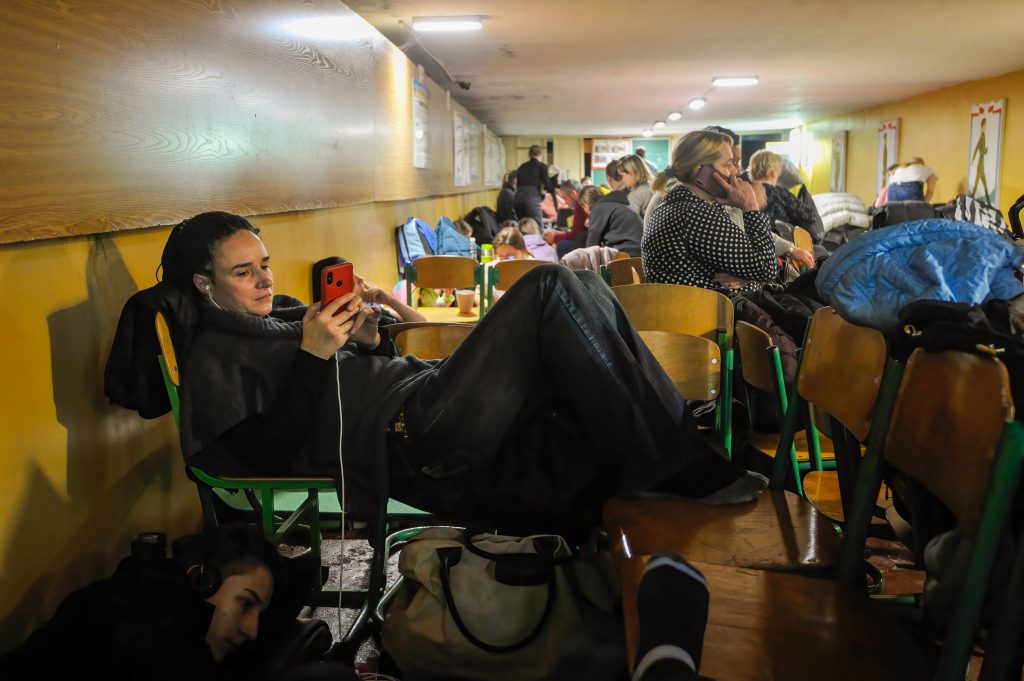
Ukrainians are asking from bomb shelters and underground bunkers where Western democracies are right now. I ask the same. It has come to this. Despite my deep love for the United States of America, I am ashamed.
I did not expect American boots on the ground. I understood the United States’ position on engaging militarily with Russia, even if I may have personally other views.
However, I DO NOT understand why the West is not providing massive military supplies—in particular Stinger missiles, sniper rifles, Javelin anti-tank missiles, drones, and ammunition, since Ukrainians are willing to defend themselves. I DO NOT understand the slow rollout of economic, financial, and energy sanctions.
Continue reading
FEBRUARY 26, 2022 | 2:34 PM WASHINGTON, 9:34 PM KYIV
Kremlin media used claims of Ukraine creating a dirty bomb to justify invasion
Following the seizure of Ukraine’s Chernobyl nuclear power plant by Russian troops, Kremlin-owned outlet RIA accused Ukraine of “almost creating a dirty nuclear bomb.” The unsupported claim cites a February 22 interview with Russian President Vladimir Putin, in which he stated that even the appearance of tactical nuclear weapons in Ukraine is a strategic threat for Russia. The same narrative was spread just prior to the Russian invasion. The accusation, repeatedly presented without any evidence, is being circulated on multiple platforms, including YouTube, Facebook, VK, and various websites.
Continue reading
FEBRUARY 26, 2022 | 11:00 AM WASHINGTON, 6:00 PM KYIV
Polish social media accounts revive anti-Ukrainian sentiments
Over the course of Russia’s military build-up prior to invading Ukraine, some Polish social media accounts started to disseminate anti-Ukrainian and pro-Russian content. According to a DFRLab analysis, these mentions of anti-Ukrainian Polish hashtags significantly increased after Russia invaded Ukraine on February 24, 2022.
Continue reading
FEBRUARY 25, 2022 | 8:11 PM WASHINGTON, 3:11 AM KYIV
View from Kyiv: Trying to sleep under assault
Terrell Jermaine Starr, a nonresident senior fellow at the Council’s Eurasia Center, described the scene tonight in Kyiv as Russia’s attack continues.
FEBRUARY 25, 2022 | 7:35 PM WASHINGTON, 2:35 AM KYIV
Mexican YouTube channels claim the US will invade Mexico in response to the Russian invasion
Videos posted in Spanish by Tu COSMOPOLIS, a Mexican channel that describes itself as a platform spreading “verified information,” and Campechaneando, a YouTuber close to Mexico’s President Andrés Manuel López Obrador (AMLO), amassed hundreds of thousands of views by misleadingly claiming that the United States will invade Mexico in the wake of Russia’s invasion of Ukraine.
Tu COSMOPOLIS and Campechaneando posted the videos on February 23 and February 24 respectively. Both videos distorted an interview with former US President Donald Trump and misleadingly claimed that he suggested that the United States will invade Mexico’s northern states in response to the Russian invasion of Ukraine. Campechaneando also suggested that US President Joe Biden will follow up on the false statement attributed to Trump. Tu COSMOPOLIS and Campechaneando videos garnered 458,000 and 385,000 views, respectively, as of Friday evening.
Although Trump mentioned Mexico three times, he did not suggest an invasion of the country. Instead, Trump proposed to increase the presence of security forces on the southern border—on US territory—to prevent “millions of people [who] are bum-rushing our country” from “127 countries,” not just Mexico.
In another video posted on February 22, Campechaneando also claimed that Russia’s Vladimir Putin told AMLO that the United States will defeat Mexico and invade the country. Campechaneando did not show Putin’s statement or quote him. However, Putin’s claims about the United States stealing Mexican territories first appeared in 2014, prior to AMLO becoming president, when Putin used the 1848 Guadalupe-Hidalgo agreement between the US and Mexico as an argument to defend the 2014 Russia-Ukraine armed conflict. The video garnered 450,000 views.
The DFRLab could not find a connection or coordination between the Tu COSMOPOLIS and Campechaneando channels.
—Daniel Suárez Pérez, Research Assistant for Latin America, Colombia
FEBRUARY 25, 2022 | 4:21 PM WASHINGTON, 11:21 PM KYIV
Not just Ukraine: Putin wants to remake the world
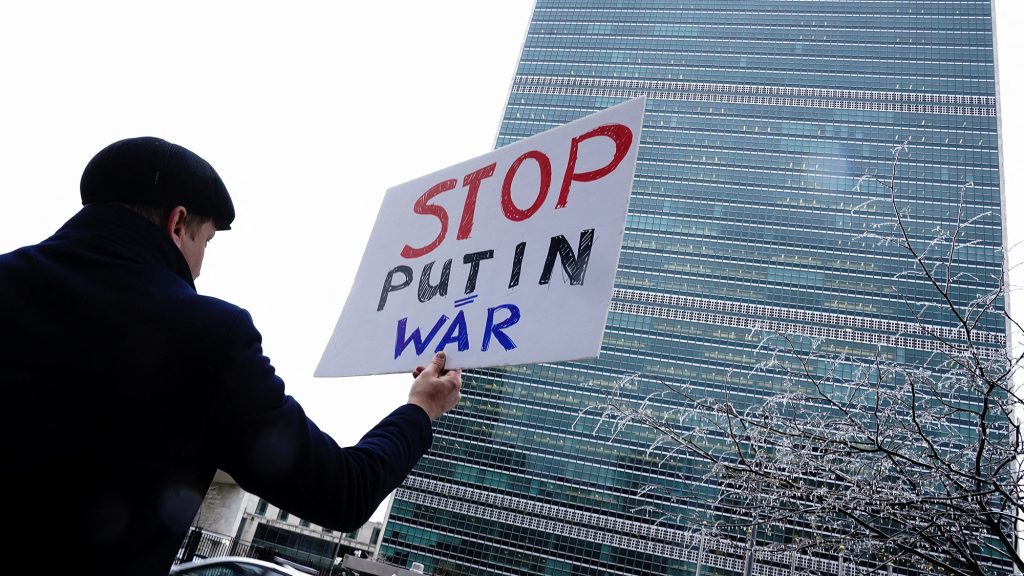
By Ana Palacio
The Art of War, Sun Tzu’s military treatise drafted in fifth-century BC China, has never lost its salience. The imperative to know one’s enemy as well as oneself has been a common refrain in military academies and diplomatic training. Yet, this charter of battlefield strategies just gained renewed relevance in the context of Russia’s invasion of Ukraine.
Russian President Vladimir Putin offered his reasoning for the “special military operation” in a Monday speech littered with contrived grievances and a self-serving perversion of history. Putin’s address can only be characterized as unhinged and reminiscent of the worst Soviet-era propaganda in which white is black and the aggressor is a victim. He proclaimed the independence of Donetsk and Luhansk, regions in eastern Ukraine held by Kremlin-backed rebels. He negated Ukraine’s sovereignty, culture, and identity.
Then on Thursday, announcing the start of the invasion, he described Ukraine’s government as an illegitimate junta and the country’s turn away from Moscow since the Maidan square protests of 2014 as the outcome of a coup orchestrated by the West. If the world wasn’t staring at a great tragedy, Putin’s bizarre tone and awkward efforts to project (forced) consensus through a televised meeting of the country’s security council would have been stunning political theater.
Experts have been cautioning of a new Cold War for months. Russia’s military offensive marks the launch of an era vastly different from the security landscape of the second half of the twentieth century. The West must confront the ways in which it will be impacted.
Continue reading
FEBRUARY 25, 2022 | 2:52 PM WASHINGTON, 9:52 PM KYIV
The effects of this war will be felt far beyond Europe—including in Latin America
Share this entry by copying this link.
Putin’s unprovoked attack on Ukraine will create economic and diplomatic ripple effects globally, including in Latin America.
Russia is one of the world’s biggest producers and suppliers of oil, so its decision to invade will negatively affect oil-importing countries. The same can be said for the agriculture sector: Russia and Ukraine together produce nearly a quarter of the world’s wheat, so the invasion will negatively affect grain importers. With countries in Central America and the Caribbean importing oil and grains from Russia, the latest developments will lead to higher consumer costs for basic foodstuffs.
Granted such potential impacts, the reaction from Latin America has been mixed. Heads of state have for the most part spoken out on the situation and what it means for liberal democratic values, sovereignty, and international law.
Argentina, Colombia, Costa Rica, Chile, Ecuador, Guatemala, and UNSC-seat holder Mexico have explicitly called out Russia as the aggressor. Argentina’s condemnation is important given the controversial trip of President Alberto Fernandez to Moscow only weeks earlier. Chilean President-elect Gabriel Boric Chile condemned the invasion as well. The Caribbean Community called Russian moves a violation of Ukraine’s sovereignty.
Guatemala’s foreign ministry requested a ceasefire and called for an extraordinary meeting at the Organization of American States (OAS). The OAS Permanent Council meets on February 25.
In contrast, UNSC-seat holder Brazil, Russia’s largest economic partner in the region, has withheld forceful condemnation. Brazilian President Jair Bolsonaro has instead focused his rhetoric on protecting Brazilians in Ukraine. While Brazilian Vice President Hamilton Mourao strongly condemned the Russian attack, Bolsonaro responded by saying that Mourao does not speak for the Brazilian government. Bolsonaro visited Putin in Moscow last week publicly expressing “solidarity” with Russia and claiming at the time that Putin seeks peace. Brazil is a major non-NATO ally of the United States.
Bolivia, a longtime ally of Russia, has lamented the attacks without calling out a specific aggressor. Yet others—El Salvador and Honduras—have refrained from speaking on the events. And, not surprisingly, in the least free countries in the region— Cuba, Nicaragua, and Venezuela—leaders have chosen to defend or applaud Russia’s incursion, a stark reminder that Russia retains strong influence with illiberal states. Just last week, Russian Deputy Prime Minister Yuri Borisov met with Venezuela’s Nicolás Maduro; since then, Maduro chose to fully and unequivocally support the Kremlin’s plans. Meanwhile Nicaraguan President Daniel Ortega, after a recent call with Putin, garnered international attention for his prompt support of Russia’s stance vis-à-vis Donetsk and Luhansk.
These reactions and nonreactions to Putin’s attack from leaders across Latin America and the Caribbean have once again highlighted ideological divides in the region, as well as the importance of the region’s alliances founded upon democratic principles, in contrast to the continued and renewed influence of Putin on the region’s remaining authoritarian regimes.
—Jason Marczak is director of the Atlantic Council’s Adrienne Arsht Latin America Center. Follow him on Twitter at @jmarczak. Maria Fernanda Bozmoski is deputy director, programs, at the Adrienne Arsht Latin America Center.
FEBRUARY 25, 2022 | 2:33 PM WASHINGTON, 9:33 PM KYIV
Will Russia turn to cryptocurrency to evade sanctions blows?
Share this entry by copying this link.
On Thursday morning, after Russia began its attack on Ukraine, Bitcoin fell to $34,702.18, its lowest level in a month. Ether was down 6 percent in early morning trade. Both have since recovered, with Bitcoin gaining 13 percent at market opening on Friday morning. Bitcoin and other cryptocurrencies are trading at 40 to 50 percent lower levels than their highs in November and December of last year. Their prices have been correlated to other stock market indices.
All of this shows that despite major news outlets reporting Russia will turn to cryptocurrency to avoid sanctions, the reality is much more complicated. Analysts believed that cryptocurrencies such as Bitcoin could be sanctions resistant and prove to be risk-averse investments in times of crisis. However, higher prices for Brent crude oil, agricultural commodities, and gold in contrast with lower prices for cryptocurrency suggest that traders have a clear preference against cryptocurrencies during this crisis—and the Russian financial system is not using it at the moment.
The timing is important. On Monday, the Russian Ministry of Finance introduced a bill aimed at regulating and taxing cryptocurrencies. The bill says that cryptocurrency should function as an investment tool instead of a payments or currency tool and imposes reporting, know-your-client, and licensing requirements for all digital currency transactions. The Ministry of Finance aims to regulate the use of cryptocurrencies within Russia through security requirements and taxation.
Perhaps the more significant development is from the Central Bank of Russia. Just as the invasion was beginning, the central bank announced that it had created a prototype of its central bank digital currency platform and that two partner banks had successfully completed a full cycle of digital ruble transfers through mobile banking applications. But again, despite outlets reporting otherwise, these tools are months—if not years—away from being an effective means of sanctions evasion.
—Ananya Kumar is the assistant director for digital currencies at the Atlantic Council’s GeoEconomics Center
FEBRUARY 25, 2022 | 1:05 PM WASHINGTON, 8:05 PM KYIV
Experts react: What does the Russia-Ukraine conflict mean for Turkey?
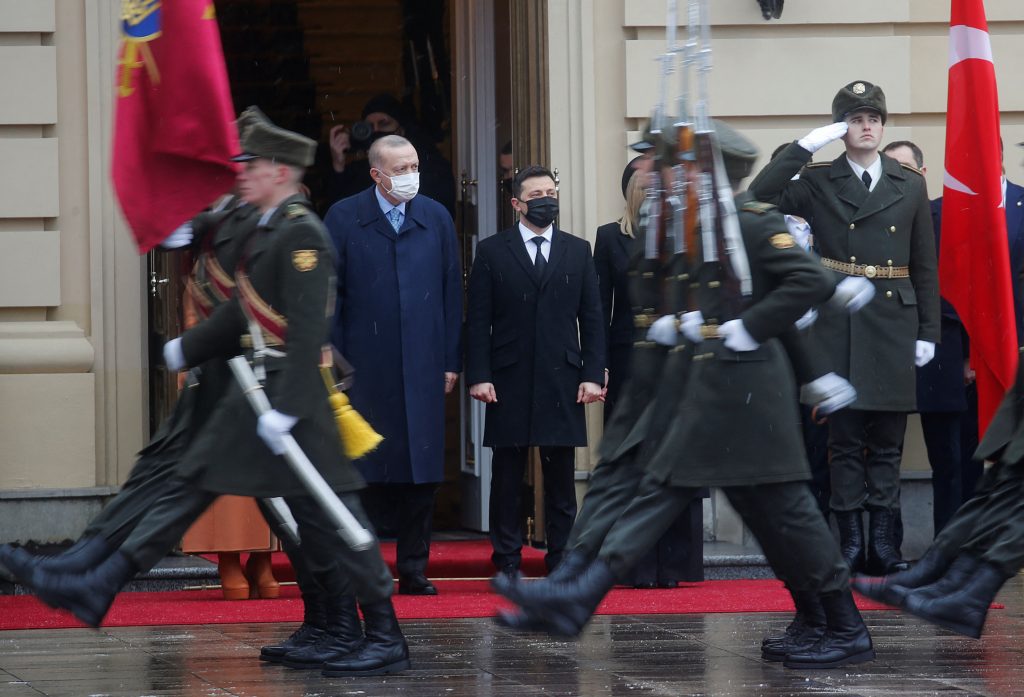
By Atlantic Council IN TURKEY experts
The Atlantic Council IN TURKEY asked experts for their take on Turkey’s stance and reaction to the conflict, as well as the role of the Turkish Straits and effects of the conflict on Turkish and European energy security.
Continue reading
FEBRUARY 25, 2022 | 12:39 PM WASHINGTON, 7:39 PM KYIV
‘War’ isn’t mentioned on pro-Kremlin and Kremlin-owned media outlets
Share this entry by copying this link.
As the international community condemns Russia’s war in Ukraine, pro-Kremlin and Kremlin-owned media outlets are refusing to use the term “war,” instead referring to the situation in Ukraine as a “special military operation.”
The DFRLab analyzed the headlines of four major outlets known for pushing the Kremlin’s agenda: Sputnik Georgia, Zvezda, Ria Novosti, and RT. The findings revealed that the outlets commonly used variants of “special military operation” like “special operation” and “military operation” instead of “war” or “invasion,” the terms widely used by independent media to describe the situation in Ukraine. For example, the Russian-language edition of state-owned RT placed a banner on its website reading “special operation.”
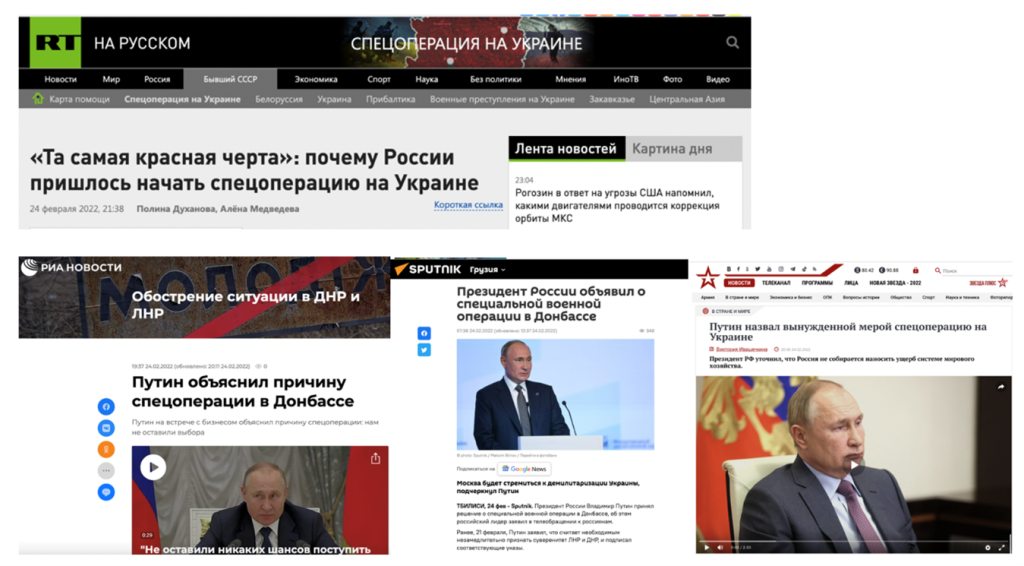
However, RT seems to have no issue using the term “war” when describing Ukraine’s actions. On February 22, two days before Russia’s invasion, RT’s English-language platform published an article titled “How Ukraine’s ‘Revolution of Dignity’ led to war, poverty and the rise of the far-right.” The article also uses the term “Nazi” twenty-three times while pushing the narrative of a “Nazi Ukraine”—one of the justifications used by Putin when announcing the invasion into Ukraine on February 24.
—Sopo Gelava, Research Associate, Tbilisi, Georgia
FEBRUARY 25, 2022 | 8:49 AM WASHINGTON, 3:49 PM KYIV
Ukraine prepares to discuss neutrality
Last night, @ZelenskyyUa seemed to offer neutrality. Understandable. Kremlin demands surrender (demilitarization and “de-nazification). Meaning under Russia’s control with pro-Kremlin puppet rulers. https://t.co/49Dke8js3d
— Daniel Fried (@AmbDanFried) February 25, 2022
FEBRUARY 25, 2022 | 10:03 AM WASHINGTON, 5:03 PM KYIV
Social media war: Meta establishes monitoring center, Patreon bans military fundraising, Russian accounts under new scrutiny
Share this entry by copying this link.
Meta announced the creation of a “Special Operations Center” to monitor Ukraine war content on Facebook and Instagram. This model was previously deployed during the Taliban’s takeover of Afghanistan in August 2021, as well as in select elections beginning in 2018. Meta further activated a one-click privacy tool that it developed after the fall of Afghanistan to shield Afghans from Taliban surveillance and reprisals. The tool renders all user data, including profile pictures, inaccessible to any account that has not been directly added by that user.
Patreon removed a fundraising campaign for Come Back Alive, a Ukrainian charity organization that collects donations for the Ukrainian military and which was founded in 2014. The fundraiser had gone viral on February 23 when Twitter users discovered that different donation tiers were tied to different pieces of military equipment (e.g. $4 for a bullet, $299 for a tank.) While Come Back Alive claimed that the $250,000 raised since the invasion had disappeared, Patreon stated that the funds would be given to the charity. Patreon has a longstanding ban on the financing of violent activities, although this policy has been inconsistently enforced in the past.
Lastly, social-media companies are being pressured to remove Russian diplomatic and media accounts from their platforms. Following the initial bombardment by Russian forces, the official Twitter account of Ukraine (@Ukraine) appealed directly to Twitter users and Twitter policy staff to remove the @Russia handle. Russian media also reported that Facebook had imposed restrictions on the social media accounts of RIA Novosti, the state-owned media conglomerate whose properties include RT and Radio Sputnik. At the time of this reporting, however, the pages were still accessible.
—Emerson T. Brooking, Resident Senior Fellow, Washington, DC; and Ingrid Dickinson, Young Global Professional, Washington, DC
FEBRUARY 25, 2022 | 10:03 AM WASHINGTON, 5:03 PM KYIV
Pro-Kremlin disinformation aims to diminish trust in Ukrainian army’s capabilities
Share this entry by copying this link.
Debunks published by Ukrainian fact-checkers reveal that pro-Kremlin media have pivoted from spreading disinformation that paints Ukraine as the aggressor to disinformation that implies the Ukrainian army is demoralized.
Since Russia’s full-scale military assault began on February 24, Ukrainian fact-checkers have seen an increase in stories that focus on the demoralization of Ukraine’s armed forces. One narrative claimed that servicemen with the 57th Separate Motorized Infantry Brigade gave up their arms and defected to the so-called Luhansk People’s Republic; a second said that Ukrainian forces were abandoning their positions en masse; and a third claimed that the Ukrainian army was not resisting Russia. All these stories were debunked by StopFake.org, the Ukrainian fact-checking collective.
Additionally, Kremlin-controlled television channel Russia-24 accused Ukraine of sharing disinformation about its victories. The Facebook page for Ukraine’s ground forces announced the capture of two Russian prisoners of war (POW), sharing a photo of the men, potentially in violation of the Geneva Convention. Russia-24 said this claim was false because snow was visible in the photo and “there is no snow in the streets.” In the image, the POWs are standing in a wooded area, where snow typically remains on the ground longer than in streets.
In addition, Russia-24 suggested that a report from Ukraine’s State Emergency Service about a fire in an apartment building in Chuguiiv, which killed a young boy, was false. Russia-24 claimed that “journalists contacted the mother and it turned out that everyone is safe and sound.” The story did not include any evidence of them contacting the mother.
Russia’s Ministry of Defense has only reported about its success in Ukraine and has not mentioned any casualties among its forces, while Ukraine’s Ministry of Defense claimed eight hundred Russian soldiers have been killed, which cannot be verified.
—Nika Aleksejeva, DFRLab Lead Researcher, Riga, Latvia
FEBRUARY 25, 2022 | 8:30 AM WASHINGTON, 3:30 PM KYIV
NATO activated its defense plans. What happens now?
On Thursday morning, the North Atlantic Council (NAC) decided to enact certain NATO defense plans in response to Russia’s unprovoked invasion of Ukraine. What do these plans actually mean for the allied response to the invasion?
While exact details of the defense plans—also called Graduated Response Plans (GRPs)—are scarce, the plans change the way that NATO is able to take action and execute command and control over allied troops. The GRPs are, in effect, the basis for a defensive campaign plan that outlines where a set group of NATO forces will deploy during a crisis. The members of the NAC are all familiar with the plans and routinely exercise them at a political and strategic level, which speeds up decision making for the Alliance. Operationally, activating the GRPs shortens the reaction time for the associated allied forces, meaning that these units can be deployed quicker. The main component of any initial NATO reaction would be provided by the forty-thousand strong NATO Response Force, for which the United States recently designated 8,500 troops. The GRPs also lay out requirements for the generation of additional forces if the situation warrants. When activating the defense plans, additional authority is given to General Tod Wolters, Supreme Allied Commander Europe (SACEUR). With this authority, SACEUR is able to make quicker decisions regarding troop deployments, enabling the Alliance to accelerate its ability to move those pre-designated forces under NATO command to Eastern Europe as soon as a political decision is made by the NAC. The highest-readiness element of the NRF is the Very High Readiness Joint Task Force (VJTF) which currently consists of 3,500 troops from a joint Franco-German brigade which could deploy to Eastern Europe within days if called upon. Full activation of the NRF and confirmation of specific national contributions of troops to the formation could come following an emergency NATO summit that is taking place Friday morning, giving SACEUR a larger pool of forces to work with during the crisis.
These NATO forces would add to allied and US forces already moving to Central and Eastern Europe and join those forces that have already been deployed over the last several weeks. Like these earlier deployments, troops under SACEUR’s command would not be sent to fight in Ukraine, but rather would serve to assure eastern allies of NATO’s commitment to their security and deter Russia from undertaking any aggression toward NATO allies. While deployments so far have been billed as temporary, these forces could also serve as a “down payment” for NATO’s future force posture in Europe in light of the new strategic reality on the ground.
—Connor McPartland is an assistant director at the Scowcroft Center for Strategy and Security’s Transatlantic Security Initiative.
FEBRUARY 24, 2022 | 6:19 PM WASHINGTON, 1:19 AM KYIV
How to get Russia right
Share this entry by copying this link.
First it was delayed by the crisis with Russia over Ukraine. Now it’s been held up by war. Yet the Biden administration’s National Defense Strategy (NDS) remains eagerly anticipated among defense analysts in the United States and around the world. On February 18, in fact, US Defense Secretary Lloyd Austin said that the US response to Russian aggression against Ukraine has foreshadowed components of the strategy. The next NDS must come to grips with the threat posed by Russia, emphatically displayed this week by the Kremlin’s brutal and large-scale invasion of Ukraine. The document must provide an actionable defense strategy for competing with, deterring, and preparing to militarily confront and, if necessary, defeat Russia. In short, the next NDS must get Russia right.
As this year’s Russia-Ukraine crisis has escalated, the Forward Defense initiative in the Atlantic Council’s Scowcroft Center for Strategy and Security has been drafting an issue brief that provides a roadmap for how the forthcoming NDS can address the Russia threat and develop a clear defense strategy designed to achieve four primary security goals in Europe:
- Protect and assure the sovereignty and territorial integrity of NATO allies
- Safeguard a stable Europe free from aggression
- Enhance defense integration with European allies and partners
- Maintain access to key geostrategic “high grounds” and choke points that are critical to the United States’ ability to conduct military operations in Europe.
While Russia’s military offensive in Ukraine certainly presents challenges to these goals, I along with my co-authors Clementine Starling and Christian Trotti lay out three pillars for confronting the Russian threat, deterring further aggression, and enhancing the security environment in Europe:
- The US must counter Russian “gray-zone” activities and take the offensive against Russian hybrid-conflict efforts.
- The US must more meaningfully integrate its European allies and partners into its plans, posture, and preparation for the defense of Europe.
- The US Defense Department must adopt a more globally oriented force-posture model that balances the simultaneous strategic challenges posed by China and Russia.
The security environment in Europe fundamentally changed this week with Russia’s invasion of Ukraine. So too should US and allied defense strategies. Check out our full issue brief here.
—Lt. Col. Tyson Wetzel is the senior US Air Force fellow for 2021-22 at the Scrowcroft Center for Strategy and Security. The opinions, conclusions, and recommendations expressed or implied here are solely those of the author and do not necessarily represent the views of the Department of Defense or any other US government agency.
FEBRUARY 24, 2022 | 6:13 PM WASHINGTON, 1:13 PM KYIV
Is there a risk of a NATO vs. Russia war?
Our experts Emma Ashford, senior fellow at the Scowcroft Center for Strategy and Security, and Matthew Kroenig, deputy director of the Scowcroft Center for Strategy and Security, tackle whether there is a risk of a NATO vs. Russia war in their latest edition of “It’s Debatable” in Foreign Policy.
Continue reading
FEBRUARY 24, 2022 | 2:58 PM WASHINGTON, 9:58 PM KYIV
Experts React: Russia has launched a war against Ukraine. How can the West fight back?
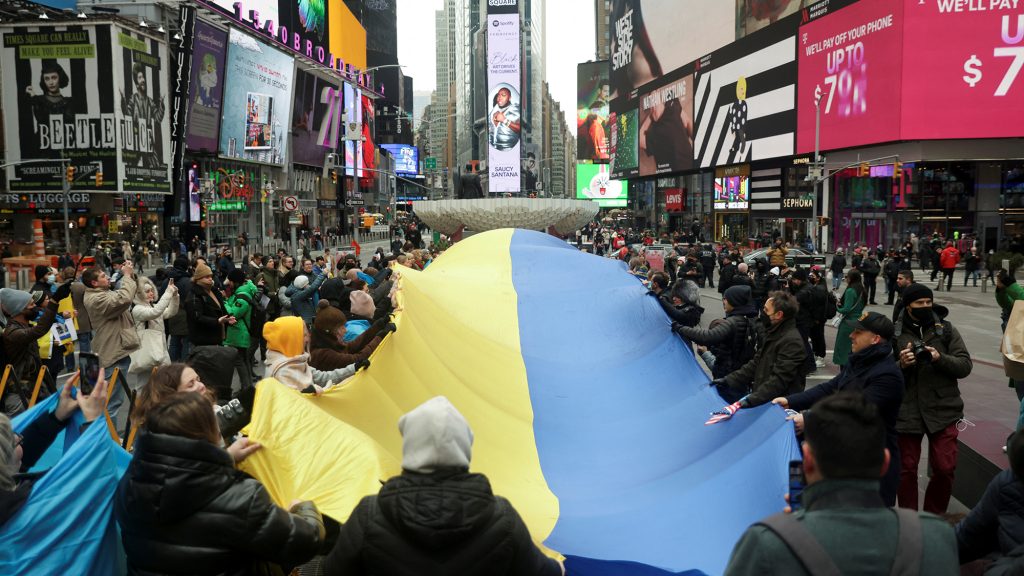
Share this entry by copying this link.
With Russia launching a full-scale assault on Ukraine on Thursday, a major war has begun in Europe with sweeping global implications. Our experts are weighing in with their insights about where this conflict is headed next and how the West can respond. We will update this post as they react to the latest developments in this crisis.
Continue reading
FEBRUARY 24, 2022 | 1:55 PM WASHINGTON, 8:55 PM KYIV
Twitter says ‘human error’ caused researcher accounts to be suspended
Share this entry by copying this link.
Twitter cited “human error” after suspending the accounts of several open-source researchers on Wednesday. The social media company dismissed rumors that the removals were the result of a mass reporting campaign. “A small number of human errors as part of our work to proactively address manipulated media resulted in these incorrect enforcements,” said Yoel Roth, head of site integrity at Twitter. “We’re fixing the issue and reaching out directly to the affected folks.”
Bellingcat analyst Nick Waters published a thread listing more than a dozen legitimate accounts that Twitter had suspended. Those with suspended accounts included Roman Burko, the founder of the open-source research collective InformNapalm; Kyle Glen, OSINT researcher and cofounder of Conflict News; Serhii Sternenko, a Ukrainian right-leaning activist from Odesa; and Maria Avdeeva, research director at the European Expert Association. By Thursday, all of the accounts cited by Waters except @ukrwarreport had been restored.
—Nika Aleksejeva, DFRLab Lead Researcher, Riga, Latvia
FEBRUARY 24, 2022 | 1:55 PM WASHINGTON, 8:55 PM KYIV
Putin’s United Russia party suspected of initiating online flash mob to support separatist independence
Share this entry by copying this link.
Shortly after Russian President Vladimir Putin recognized the independence of the Donetsk and Luhansk peoples republics on February 21, a pro-Russia online flash mob began tweeting using the hashtags #СвоихНеБросаем (#WeDoNotAbandonOurPeople) and #МыВместе (#WeAreTogether). The campaign expressed support for people living in Donetsk and Luhansk, alleging that they are suffering under Ukrainian Armed Forces. The Twitter campaign created the impression that there is public support for Putin’s decision.
Open-source evidence suggests Putin’s United Russia party could have initiated the flash mob. United Russia started using the #СвоихНеБросаем hashtag on February 20, the day before the Putin’s announcement, calling on their audience to give humanitarian assistance to people evacuated from Donbas to Rostov Oblast. Later, United Russia continued to use the hashtag for other purposes.
The DFRLab analyzed the hashtags on Twitter and found 59 percent of the mentions were original tweets (1005 out of 1709). Each tweet received an average of 26.4 engagements, suggesting the campaign failed to go viral. The most popular tweet had 223 engagements.
Analyzing the hashtags on Facebook using the monitoring tool CrowdTangle, the DFRLab found that the most engaged–with content came from United Russia accounts or the accounts of their prominent members. The highest number of engagements a post received was 1,300 reactions, 140 comments and 124 shares, which is not considered particularly high. A CrowdTangle query identified 202 posts on Facebook pages, public groups, and verified profiles that received an average of 39 engagements. Meanwhile, a CrowdTangle analysis of Instagram found that 509 posts have used the hashtag since February 20, receiving an average of 720 engagements.
The DFRLab found the hashtag was also used on other social media platforms, such as VKontakte, Odnoklassniki, and Telegram, but has yet to determine their levels of engagement.
—Nika Aleksejeva, DFRLab Lead Researcher, Riga, Latvia
FEBRUARY 24, 2022 | 1:55 PM WASHINGTON, 8:55 PM KYIV
Ukrainian Defense Minister calls on all Ukrainians to mobilize
Share this entry by copying this link.
Ukraine’s Minister of Defense Oleksiy Reznikov called on all Ukrainians “who are ready and able to hold a weapon” to mobilize. According to a statement posted on Facebook early Thursday morning, Ukraine has entered “total defense mode.” Reznikov said all that is required to join the ranks of the armed forces is a passport. “The enemy is attacking, but our army is indestructible,” he added.
Following the defense minister’s statement, Ukrainian President Volodymyr Zelenskyy tweeted a similar statement: “We will give weapons to anyone who wants to defend the country. Be ready to support Ukraine in the squares of our cities.”
—Eto Buziashvili, Research Associate, Tbilisi, Georgia
FEBRUARY 24 2022 | 1:10 PM WASHINGTON, 8:10 PM KYIV
America must act—our security and prosperity are at stake in Putin’s war on Ukraine
“Nothing less than American security and prosperity are at stake. The principal destroyer of lives and wealth is war between large powers,” writes Eurasia Center Director John Herbst in the New York Post.
Continue reading
FEBRUARY 24 2022 | 12:00 PM WASHINGTON, 7:00 PM KYIV
It’s official: The post-Cold War era is over
“Today, America is faced with the harsh reality of power politics: a conflict we could not prevent, and the very real risk of military escalation,” writes Emma Ashford, a resident senior fellow with the New American Engagement Initiative in the Scowcroft Center for Strategy and Security, in the New York Times. “For so long, American policymakers have grappled with how to prevent such a moment. Now, they must answer a different question: How should the United States adapt to this new reality?”
Continue reading
FEBRUARY 24, 2022 | 11:13 AM WASHINGTON, 6:13 PM KYIV
Baltic countries and Poland invoke NATO’s Article 4
Share this entry by copying this link.
Lithuania, Latvia, Estonia, and Poland invoked Article 4 of NATO’s founding treaty today, triggering consultations with alliance members. Article 4 states that “the Parties will consult together whenever, in the opinion of any of them, the territorial integrity, political independence or security of any of the Parties is threatened.”
Following initial consultations, NATO issued a statement saying “we have decided, in line with our defensive planning to protect all allies, to take additional steps to further strengthen deterrence and defense across the alliance.”
This comes as NATO held an emergency meeting today to discuss Russia’s assault on Ukraine. NATO Secretary-General Jens Stoltenberg stated that Russia’s attack on Ukraine “is a grave breach of international law, and a serious threat to Euro-Atlantic security.”
—Eto Buziashvili, Research Associate, Tbilisi, Georgia
FEBRUARY 24, 2022 | 11:01 AM WASHINGTON, 6:13 PM KYIV
Ukraine government and civil society websites targeted by cyberattacks prior to invasion
Share this entry by copying this link.
A pair of cyberattacks targeted Ukrainian banks and government websites during the twenty-four hours leading up to the Russian invasion. Targets included the web pages for the Ukrainian parliament, Ministry of Foreign Affairs (MFA), and Cabinet of Ministers.
According to the internet monitoring website IsItDownRightNow.com, the websites for the MFA and Cabinet of Ministers were temporarily taken offline on Wednesday. Over several hours, the DFRLab also observed that Ukraine’s security services website would only partially load.
Mykhailo Fedorov, Ukraine’s Minister of Digital Transformation, confirmed a large-scale distributed denial-of-service (DDoS) attack had occurred. He claimed that unknown actors attacked Ukrainian banks, state servicer provider Diia, and the websites for the Ukrainian parliament, the MFA, and the Cabinet of Ministers. Fortunately, many of the services continued working despite the ongoing attack.
Fedorov confirmed that cyberattacks continued throughout the night and were ongoing. He claimed that all information sources in Ukraine were under attack, but assured citizens that the situation was under control. As of Thursday morning, the websites were accessible from Ukraine.
Meanwhile, open-source research collective InformNapalm also reported a DDoS attack on their webpage. A similar attack was directed at Censor.net, a popular Ukrainian online media outlet. The organizations successfully defended against the attacks and webpage performance was not impacted.
Lastly, cybersecurity firms Symantec and ESET said they had discovered a new destructive malware wiping data from Ukrainian machines.
—Roman Osadchuk, Research Associate
FEBRUARY 24 2022 | 10:37 AM WASHINGTON, 5:37 PM KYIV
The global economy will suffer from Russia sanctions, but not for long
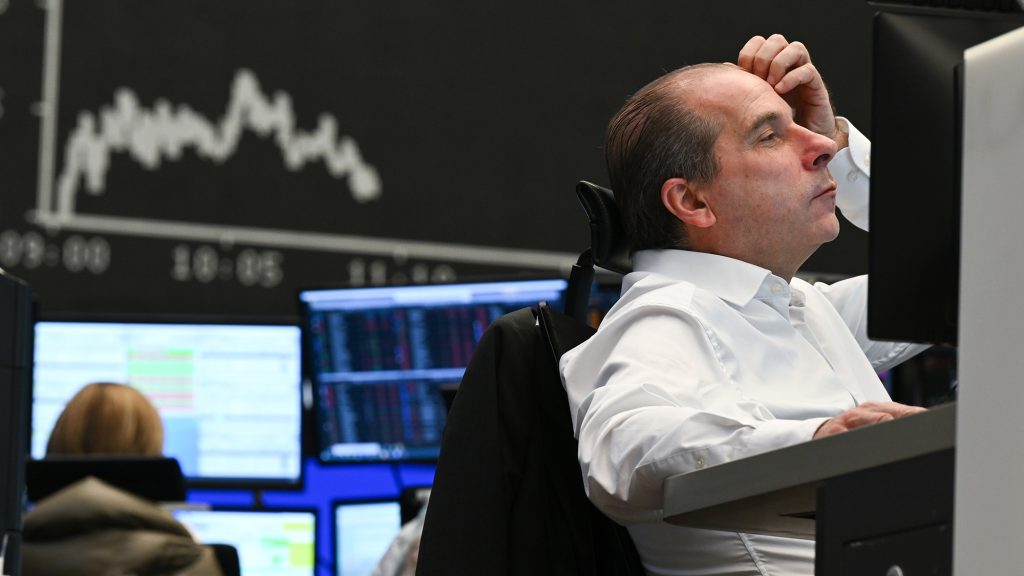
By Hung Tran
Since Russia launched a military invasion of Ukraine, the entire European security order seems to have been thrust into question.
In addition to the first round of US, British, and European sanctions—which include restrictions on Russian financial institutions and a suspension of the Nord Stream 2 natural gas pipeline—more extensive and stringent sanctions will be announced. These measures are bound to have global political and economic consequences. As Russia takes steps to retaliate against sanctions and the war in Ukraine could damage gas pipelines, an acute energy shortage is possible, leading to a global economic slowdown, but most severe in Europe, amid a spike in global oil and gas prices.
But increased production and new sources will offset the impact in a few months. Russia’s modest contribution to the global GDP—just 1.7 percent—means the world’s economic pain will pass even though the fallout of the invasion will define geopolitics for years.
Continue reading
FEBRUARY 24, 2022 | 10:08 AM WASHINGTON, 5:08 PM KYIV
Ukraine desperately needs help
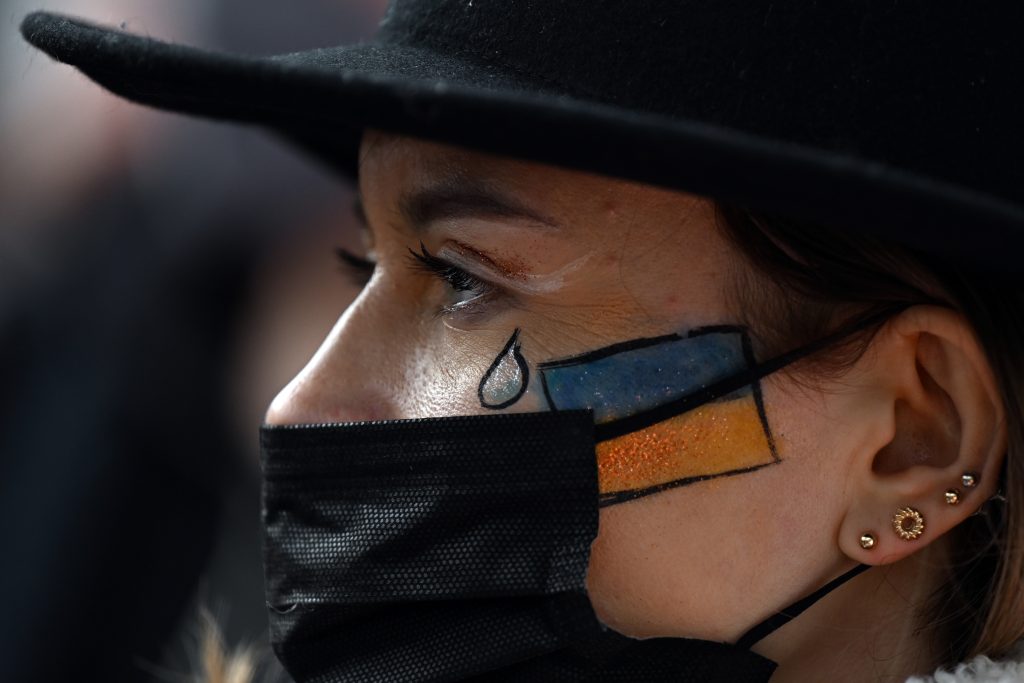
By Andrey Stavnitser
This is for everybody who reads me abroad in the United States, in Europe, all around the globe. We, Ukrainians, are now a human shield between you and the Soviet Union. Between human values, democracy, passion for development and growth—and a military regime, where human lives are only necessary to be sacrificed for the sake of Empire.
We are strong and we will fight.
But we need your support now, today, at this very moment.
Continue reading
FEBRUARY 24, 2022 | 8:14 AM WASHINGTON, 3:14 PM KYIV
Ukraine reports OSCE cars used as shields for Russian tanks
Share this entry by copying this link.
On February 24, the State Border Guard Service of Ukraine reported that columns of Russian tanks entered the Luhansk region of Eastern Ukraine through Krasna Talivka, Milove, and Horodyshche. According to the Border Guard, the columns were led by white cars bearing the logo for the Organization for Security and Co-operation in Europe (OSCE), which has monitored the conflict on a daily basis for years.
The OSCE previously announced on February 13 that it was pulling out its staff from eastern Ukraine. At the time, Kremlin outlet RT reported that OSCE had evacuated their car fleet but left behind armored vehicles.
At the time of writing, the OSCE had not commented on the matter and the DFRLab cannot independently confirm whether the OSCE vehicles allegedly being used by Russia are authentic or were Russian vehicles with OSCE logos affixed to them.
—Roman Osadchuk, Research Associate
FEBRUARY 24, 2022 | 8:14 AM WASHINGTON, 3:14 PM KYIV
Belarus enters the conflict after crossing Ukraine’s northern border
Share this entry by copying this link.
Not long after dawn on February 24, tanks were recorded moving into Ukrainian territory from southwestern Belarus, crossing over at the Senkivka checkpoint. Tanks, infantry fighting vehicles, and Russian heavy flamethrower systems can be identified in the videos. Videos showing missiles being launched from the Mogilev area towards Ukraine have also surfaced, yet have not been specifically geolocated as of now. CNN and Newsweek reported that Belarusian troops are also taking part in the attack against Ukraine, despite previous insistence from Belarusian leader Alyaksandr Lukashenka that Belarus would not participate in any military action against the country.
In an urgent meeting with Russian President Vladimir Putin, Lukashenka announced that they had agreed to keep Russian troops stationed in Belarus. Lukashenka previously denied that Belarusian troops would take part in the Ukrainian invasion. He also proclaimed that Ukraine is losing the war and offered to host talks in Minsk.
New Maxar satellite imagery released the day before the attack showed Russian military deployment changes on February 21 and 22. The new images revealed Russia had deployed more than one hundred vehicles and dozens of troop shelters at Bolshoi Bokov airfield in southern Belarus, near the city of Mazyr. This new deployment is less than twenty kilometers from the Ukrainian border. The same set of new images also documented ground being cleared southwest of Belgorod, Russia, in the general vicinity of where Russia later began its attack on Kharkiv.
That same day, the Ukrainian State Border Guard Service announced the implementation of a number of security measures along its borders with Russia and Belarus. The new measures included limiting vehicle traffic; using radio stations, drones, and filming and taking pictures; as well as keeping non-residents away from the border zone. Meanwhile, Belarusian opposition leader Sviatlana Tsikhanouskaya urged Western countries to impose tougher sanctions on both Russia and Belarus to deter them from further aggression. According to her, the current sanctions packages are not enough, as Russia and Belarus are not showing any responsiveness to them.
Viktor Gulevich, head of the Belarusian army, previously stated on February 21 that the withdrawal of Russian troops from Belarus would depend on regional NATO troop withdrawals. According to Reuters reporting, Gulevich said Minsk believed it was within its rights to demand that US and NATO member forces withdraw from near Belarusian borders, including from near borders with neighboring countries Poland, Latvia, and Lithuania.
Lastly, new footage has surfaced of Russian Ka-52 Alligator and Mi-24P combat helicopters in the Gomel region of Southeastern Belarus, potentially near the R-35 highway; however, this video has not yet been geolocated. Additional as-yet-unverified videos suggest that the southern Belarusian border where Russian troops are stationed is becoming more muddy, which might impact the tactical capabilities of Russian ground troops in the region.
—Lukas Andriukaitis, Associate Director, Brussels, Belgium
FEBRUARY 24, 2022 | 12:15 AM WASHINGTON, 7:15 AM KYIV
Experts react as Russia begins its new invasion of Ukraine
Share this entry by copying this link.
Shortly after Russia’s assault on Ukraine began in the early morning hours of Thursday, Kyiv time, Atlantic Council experts gathered for a Twitter Spaces event to break down what was happening and what to expect next. Here are just some of the highlights of the conversation.
Listen to the full audio
The @AtlanticCouncil goes live with expert reactions and analysis to Russia’s new invasion of Ukraine as Russian President Putin announces new large-scale military operations. https://t.co/KClIznB79o
— Atlantic Council (@AtlanticCouncil) February 24, 2022
What’s at stake in Ukraine
“[Vladimir] Putin—and behind Putin, Xi [Jinping]—represents a great threat to our whole way of living. We have the strength to deal with it if we have the will to do what’s necessary. … We also have to pursue the correct energy policies that have added to our woes. Our green transition must take into account what we need to do today. The United States has to become, as it was two years ago, the world’s largest energy producer. That is very, very important, to deal with the one economic asset that Putin has over us—an economic asset, by the way, of course, that China desperately needs. …
Putin has now directly challenged the prosperity and stability that we’ve enjoyed for the past thirty-plus years. And if we don’t respond to this with major, major pushback on Putin, which requires change in our own societies, we can lose this. But if we do take advantage of our advantages, which are substantial, we will win this.”
—John E. Herbst is the senior director of the Eurasia Center and a former US ambassador to Ukraine.
Can Putin take all of Ukraine?
“I think it’s possible and I think the situation on the ground is going to determine [it]. I look back at 2003: The US and coalition forces did not anticipate taking Baghdad as quickly as they did. If the Ukrainian defenses begin to collapse and [Russian forces] can make a run for the roses, if you will, and take the capital, then I can see them potentially moving further. I tend to think that’s not what’s going to happen. …
I still believe that the Ukrainians have some pretty strong defenses. They have been planning this for eight years. I think they are going to trade space for time. So potentially do a retrograde or a retreat of forces, allow the Russian ground offensive to come in and then do things like ambushes, the porcupine tactics, really bloody tactics to try to bleed the Russians white. I think this is going to be hugely costly for the Russians in the medium term. I think In the short term, it’s going to look very bad for the Ukrainians.”
—Lt. Col. Tyson Wetzel is the senior US Air Force fellow for 2021-22 at the Scrowcroft Center for Strategy and SecurityThe opinions, conclusions, and recommendations expressed or implied here are solely those of the author and do not necessarily represent the views of the Department of Defense or any other US government agency.
How big will Joe Biden now go with sanctions—and will it even matter?
“Iran, on a 100 percent [scale] of sanctions pain, [is] somewhere around 90 to 95 at the moment. Those last percentage points are really hard to get. Russia is 10 to 15 percent in my view at best. If what I just laid out [in terms of sanctions on four large Russian state-owned banks, Russian industries such as insurance and transportation, and new restrictions on Russian oligarchs] comes to bear, that’s probably 60 to 70 percent. There are some other things that the [Biden] administration could deploy, like maybe a new investment ban on the entirety of Russia. The sanctions that I brought up would still be considered targeted sanctions rather than something like a full-on financial embargo, which would cut off all Russian banks, not just the big state-owned ones. That I’m not sure would be on the table for [the day after Russia’s offensive] but might be at some point in the future. …
If you remove the ability [for Russia] to tap into the US financial markets, you kill the ability to transact currency across borders. There’s no way to prepare for that. There’s no way to insulate from that. …
Will it matter enough to get Putin to stop bombing Kyiv? I’m skeptical of that. It doesn’t make it the wrong thing to do, but I do wonder if there is kind of enough in the sanctions tool kit—even if they ratcheted up to Iran-style sanctions—to convince Putin to pull back.”
—Brian O’Toole is a nonresident senior fellow at the GeoEconomics Center and a former US Treasury Department official who helped develop the 2014 sanctions against Russia.
What could a Ukrainian refugee crisis look like?
“If Putin is intending to occupy and stay in far larger swathes of Ukraine—we’re obviously not exactly sure what this is going to look like but definitely fearing the worst—that could result in millions of refugees leaving those areas and moving over to Western Ukraine or the European Union. If you look into areas in the Donbas occupied by Russia a large amount of the population left rather than live under the gangsterism and kleptocracy of Russian puppet rule. So we need a plan now to be developed to potentially house these people, [and] potentially open borders to ensure safe passage.
This is going to put a major strain on the European Union once again after the Syrian refugee crisis, which of course had a major impact on the politics of the continent. I don’t expect this will be met with the same populist response that the Syrian refugee crisis had because the refugees are likely to end up in Poland, the Baltic [states], and Romania where they won’t be seen as sort of outsiders in the same way. But still this is going to put a major strain on these countries in terms of funding this and housing this. And something the US and the normal financial superpowers can do is really help the European Union and help these countries to fund that and get it going.”
—Ben Judah is a resident senior fellow at the Europe Center.
FEBRUARY 23, 2022 | 10:25 PM WASHINGTON, 5:25 AM KYIV
Putin announces ‘special military operation’ against Ukraine
In a televised speech, Russian President Vladimir Putin announced an operation to “demilitarize” Ukraine. The early Thursday morning speech, Moscow time, came during an emergency meeting of the United Nations Security Council to discuss the crisis.
A moment that will live in infamy: https://t.co/ocflEYhwJY
— Ben Judah (@b_judah) February 24, 2022
US President Joe Biden issued a statement, saying: “The prayers of the entire world are with the people of Ukraine tonight as they suffer an unprovoked and unjustified attack by Russian military forces.”
FEBRUARY 23, 2022 | 8:22 PM WASHINGTON, 3:22 AM KYIV
Russia Crisis Military Assessment: Is snatching a seaport Putin’s next move?
Share this article by copying this link.
In the latest edition of their weekly newsletter—update your preferences and subscribe here—our military fellows and other Scowcroft Center Forward Defense experts analyze movements in and around Ukraine to give their take on what’s next. This week, they have their eye on a strategic seaport, among other areas.
FEBRUARY 22, 2022 | 2:16 PM WASHINGTON, 9:16 PM KYIV
Dispatch from Brussels: The contrast of NATO’s consensus vs. Putin’s rule
Share this video by copying this link.
The Atlantic Council’s Barry Pavel headed to Brussels this week to meet with senior NATO officials and discuss Russia’s latest acts of aggression. Here are his takeaways:
FEBRUARY 23 2022 | 12:49 PM WASHINGTON, 7:49 PM KYIV
Putin’s long game in Ukraine
“Washington’s task is to see that Putin fails and that the West’s democratic alternative—based on a rules-based, liberal world order—prevails,” write the Atlantic Council’s Daniel Fried and the Center for European Policy Analysis’s Alina Polyakova.
Continue reading
FEBRUARY 23, 2022 | 12:21 PM WASHINGTON, 7:21 PM KYIV
Time to go after the Kremlin’s wallets
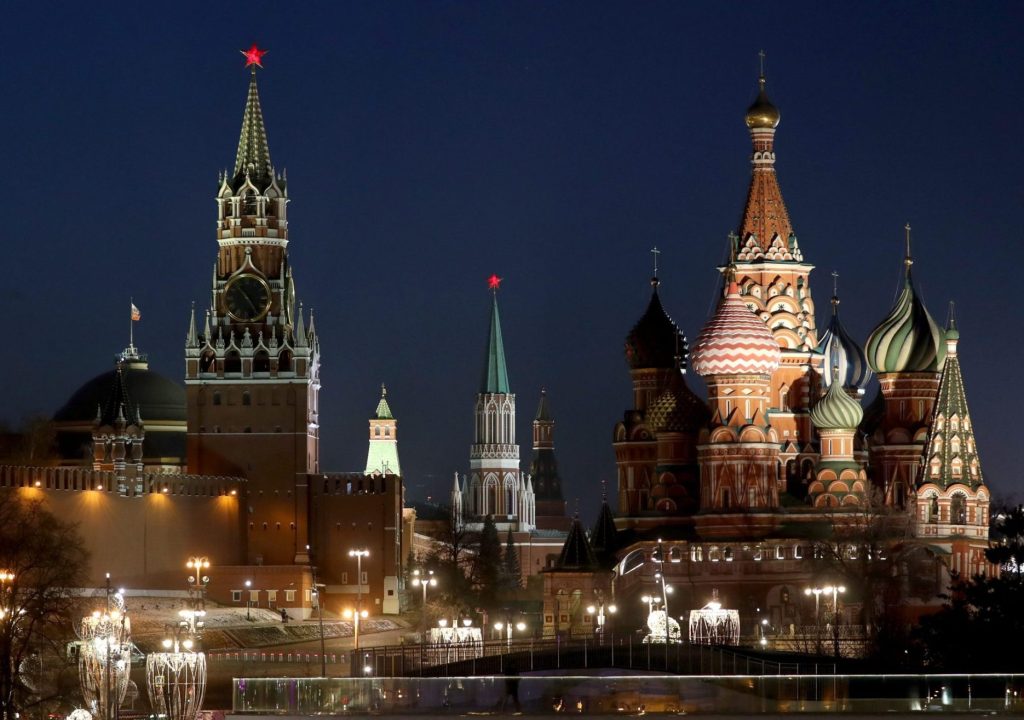
Share this article with your network by copying this link.
By Doug Klain
Russia recognized eastern Ukraine’s so-called separatist republics as independent countries on February 21, dramatically raising the stakes in the confrontation initiated late last year by Vladimir Putin. The move is short of the full-scale invasion of Ukraine that the international community has feared, but still signifies a serious violation of international law and an end to the Minsk peace process, while leaving room for further escalation and creating possible pretexts for future Russian offensives.
Throughout this crisis, Western governments have repeatedly handed the initiative to Russia while threatening action in the event of further escalations. This needs to change. Going after the Kremlin’s oligarchs and elite who stash their illicit wealth in the West is an essential move that should happen now before Putin goes further in his campaign to end Ukrainian independence and revise Europe as we know it today.
Continue reading
FEBRUARY 23, 2022 | 6:01 AM WASHINGTON, 1:01 PM KYIV
Worrying signs on Russian state television
This very public litigation of Ukraine’s borders should be extremely worrying for any Russia-watcher who knows the strategic power of state television.
— Dan Peleschuk (@dpeleschuk) February 23, 2022
Brick by brick, the case is being built. But the question of public opinion is still open (prob why they’re laying it on heavy) https://t.co/UPJ7Qvqcit
FEBRUARY 22, 2022 | 8:38 PM WASHINGTON, 3:38 AM KYIV
FAST THINKING: The West strikes back against Russia’s Ukraine incursion
FEBRUARY 22, 2022 | 2:48 PM WASHINGTON, 9:48 PM KYIV
Biden hits back with sanctions. Will they be enough?
Share this article with your network by copying this link.
After US President Joe Biden announced a new package of sanctions against Russia on Tuesday afternoon, here’s what two of our sanctions gurus had to say.
A reasonable start that falls short on promises
This is a reasonable first tranche from the Biden administration, moving in step with what the European Union (EU) is reportedly considering, assuming that there are more incremental aggressions anticipated by Moscow that will need room to escalate by the United States and its partners. Unfortunately, these sanctions do fall short of the major banking sanctions promised on both sides of the Atlantic, as no significant commercial banks were included. The newest sanctions will have impact, undoubtedly, but I fear that Putin may assess the West does not have the stomach to impose truly significant measures given the incremental nature of today’s announcement. I hope that time proves him wrong, as it is clear he has no intention of stopping with just taking the breakaway territories.
—Brian O’Toole is a nonresident senior fellow at the GeoEconomics Center and a former senior US Treasury Department official.
A solid response—in the interim
The Biden administration’s imposition of full blocking sanctions (and not lesser sanctions) against two financial institutions is critical: It sets a standard for strong future action against most of all big Russian banks. Also good was the imposition of sanctions on secondary market trading of Russian sovereign debt (bonds).
These actions seem to meet what the administration was going for: sanctions sharp enough to get Kremlin attention while leaving most in reserve. Between the US sanctions, the German decision on Nord Stream 2, and what I hope is in the EU sanctions package (e.g., sovereign debt restrictions), it’s a solid interim response to Putin’s aggression. But that means more of a warning shot. And worse aggression may be coming.
—Daniel Fried is the Weiser family distinguished fellow at the Council and a former US ambassador to Poland.
Continue reading
FEBRUARY 22 2022 | 2:31 PM WASHINGTON, 9:31 PM KYIV
Russian troops invaded Ukraine. Sanctions are in place. What happens next?
There are three scenarios about what happens next for Ukraine and Europe after Putin’s invasion, writes Eurasia Center Deputy Director Melinda Haring in USA Today.
Continue reading
FEBRUARY 22, 2022 | 12:36 PM WASHINGTON, 7:36 PM KYIV
Russian Hybrid Threats Report: Despite debunking of false flags, Putin recognizes breakaway republics
As the situation grows more precarious, today’s #RussianHybridThreatsReport🇷🇺 will examine the most serious escalations from #Putin yet, including his Monday recognition of the independence of the breakaway #Donetsk and #Luhansk people’s republics. 🧵⬇️ https://t.co/2k9tPelOWw
— DFRLab (@DFRLab) February 22, 2022
Read the report
FEBRUARY 22, 2022 | 10:29 AM WASHINGTON, 5:29 PM KYIV
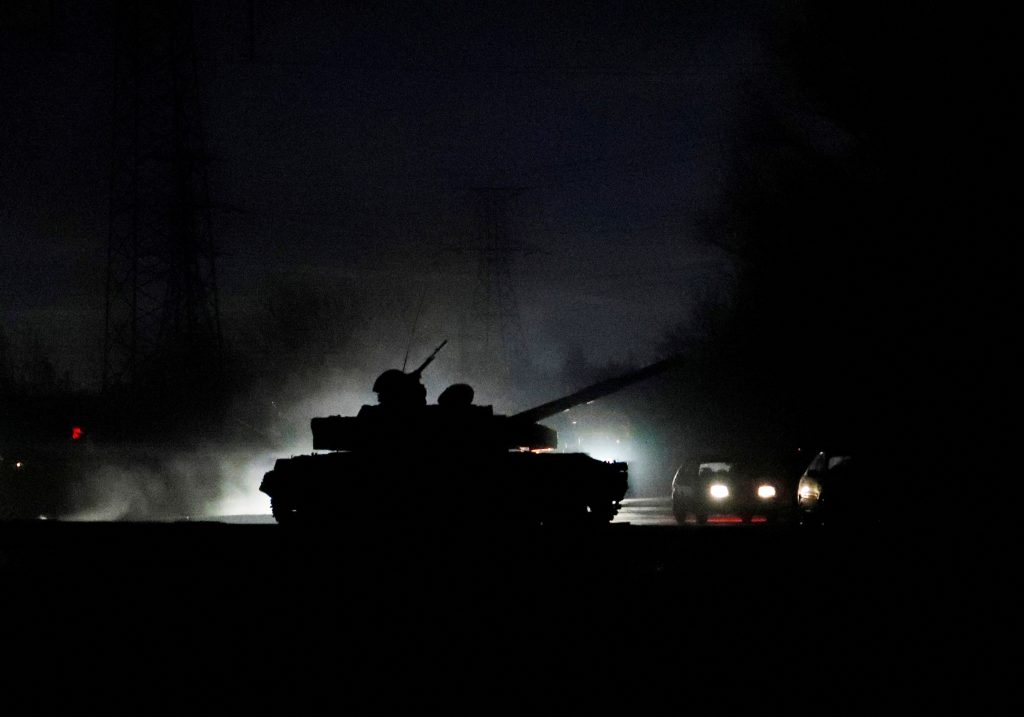
Russian outlets steadily increased claims that Ukraine will start a war
Share this article with your network by copying this link.
By Eto Buziashvili and Esteban Ponce de León
Kremlin-owned and pro-Kremlin online outlets increasingly reported over the four months leading up to Russia recognizing the independence of the breakaway republics that Ukraine is preparing to attack the Donbas region or Russia. Between November 2021 to January 2022, coverage in Russian media of the Ukrainian attack preparation narrative rose dramatically, with a nearly 50 percent increase in January 2022.
On February 21, 2022, Russian President Vladimir Putin used claims that implicated Ukraine or other Western countries as the aggressor to justify recognizing the independence of the so-called Donetsk and Luhansk People’s Republics (DNR and LNR) and sending in Russian “peacekeeping forces” into the regions. Russia, meanwhile, continues to amass combat units along the Ukraine border and in Belarus.
US intelligence and military assessments have found that Russia has enough forces in place to begin a full-blown invasion of Ukraine at any time. US officials also exposed a Russian plan to use a fabricated video as a pretext for invading Ukraine. The Kremlin denied the reports about the potential fake video, saying “similar has been said before as well. But nothing came of it.”
Continue reading
FEBRUARY 21, 2022 | 6:45 PM WASHINGTON, 1:45 AM KYIV
Experts React: Russia just ordered troops into Ukraine again. What happens next?
FEBRUARY 21, 2022 | 6:00 PM WASHINGTON, 1:00 AM KYIV
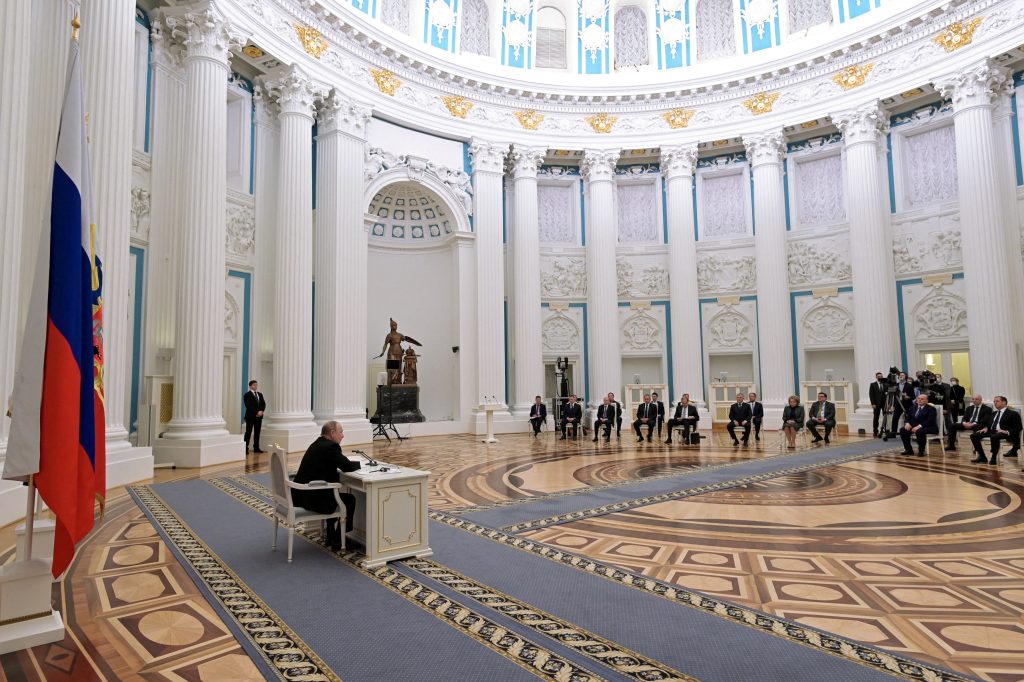
Putin escalates his Ukraine war with recognition of separatist republics
Share this article with your network by copying this link.
Almost exactly eight years to the day since he first ordered the invasion of Crimea, Vladimir Putin struck another blow in his war against Ukrainian statehood on February 21 by officially recognizing the two so-called separatist republics of eastern Ukraine as independent states.
Putin announced his decision to recognize the republics following a day of political theater in the Kremlin. The first act was an emergency session of Russia’s National Security Council held in the surreal atmosphere of a Stalinist show trial, with a who’s who of senior regime figures lining up to parrot propaganda slogans and denounce imaginary acts of Ukrainian aggression.
The main event was Putin’s televised evening address, which quickly turned into a breathless and highly emotional rant against all things Ukrainian. The Russian leader spent most of his nearly one-hour speech condemning Ukraine’s alleged faithlessness and questioning the legitimacy of Ukrainian statehood. Many of the talking points echoed Putin’s notorious July 2021 essay on the same subject, but the vitriol and contempt of his delivery was nevertheless chilling…
Continue reading
FEBRUARY 17, 2022 | 4:58 PM WASHINGTON, 11:58 PM KYIV
Twenty questions (and expert answers) about what’s happening with Ukraine and Russia
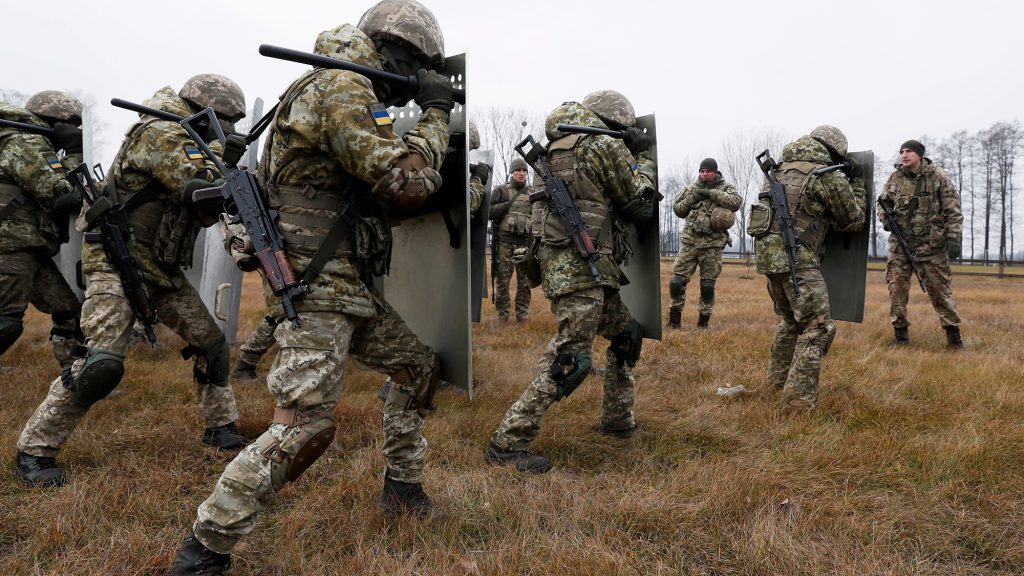
Share this article with your network by copying this link.
As the crisis in Eastern Europe continues to unfold, we tapped our expert network to answer our burning questions about the implications for Russia, Ukraine, and the wider world.
1. Why is Russia moving so aggressively against Ukraine right now?
This crisis was entirely fabricated by Russian President Vladimir Putin; there is currently no threat to Russian security from NATO or Ukraine that can justify the more than one hundred thousand troops he has deployed to Ukraine’s borders and poised for attack. Ukraine is at the center of this crisis solely because its very existence as an independent, democratic state threatens Moscow’s ability to dominate its neighbors and reverse the changes in Europe since the end of the Cold War—ones that have brought unprecedented peace, freedom, prosperity, and cooperation to all countries (including Russia). For Putin, Ukraine’s progress—despite Russia’s efforts to dismember and destabilize it—represents a dangerous example that could inspire the Russian people to seek the same freedom that Ukrainians enjoy. This would endanger the authoritarian regime Putin has built in Russia over the past two decades.
—Alexander Vershbow is a distinguished fellow at the Atlantic Council, former deputy secretary general of NATO, and former US ambassador to Russia.
2. Why has the United States been so actively engaged in this crisis?
Since at least February 2007, when he gave his infamous speech to the Munich Security Conference, Putin has been pursuing a revisionist foreign policy designed to overturn the global security order that emerged at the end of the Cold War. Putin wants to re-establish Moscow’s hegemony in the area that was controlled by the Soviet Union—including NATO members in Eastern Europe—and to weaken both NATO and the European Union. In pursuit of this objective, Moscow launched a war against Georgia in 2008, seized Crimea and sparked a not-quite-covert war in eastern Ukraine in 2014, and is now threatening to launch a major offensive against Ukraine. If Putin succeeds in Ukraine, he will turn his attention to those NATO members in Eastern Europe. This is the smart place for the United States and its allies to prevent a Putin victory, with supplies of weaponry and economic aid to Ukraine and sanctions against Russia. This does not require American troops. Failure to stop Putin in Ukraine may also give China another reason to challenge the United States over Taiwan. Beijing would take a Putin win as a sign of western and US weakness and become more confident to move on Taiwan.
—John E. Herbst is the senior director of the Council’s Eurasia Center and former US ambassador to Ukraine.
3. How widespread could this conflict get?
If Russia does conduct some kind of major invasion, then there are risks of it spiraling outside of Ukraine. There would be refugee flows that, at a minimum, could be destabilizing to neighboring countries. Given Russia’s destabilizing activities in the past, it’s even possible that they could try to infiltrate those refugee flows with special-operations forces to cause trouble in neighboring NATO countries. There’s also the possibility of a military accident. In 2015, Russia fired cruise missiles at Syria that ended up landing in Iran. Say the Russians fire a missile at Ukraine but destroy something in a NATO country: It would cause some real dilemmas for NATO leaders on how to respond.
If Putin is really rolling through Ukraine, does he see this as a possibility to go directly at a NATO country? I think he knows that would be risky. But if he could get away with it, that would be an important victory for him. Even taking a small slice of Estonia or Poland would break US President Joe Biden’s promise to “defend every inch of NATO territory.” That’s the big bright line that hasn’t been crossed yet, and if crossed, it does raise a lot of questions about the credibility of the entire Alliance. And that’s what would make it so attractive to Putin.
—Matthew Kroenig is the deputy director of the Council’s Scowcroft Center for Strategy and Security, and a former US Department of Defense and intelligence-community official.
Read more answers from our experts
JANUARY 27, 2022 | 9:15 AM WASHINGTON, 4:15 PM KYIV
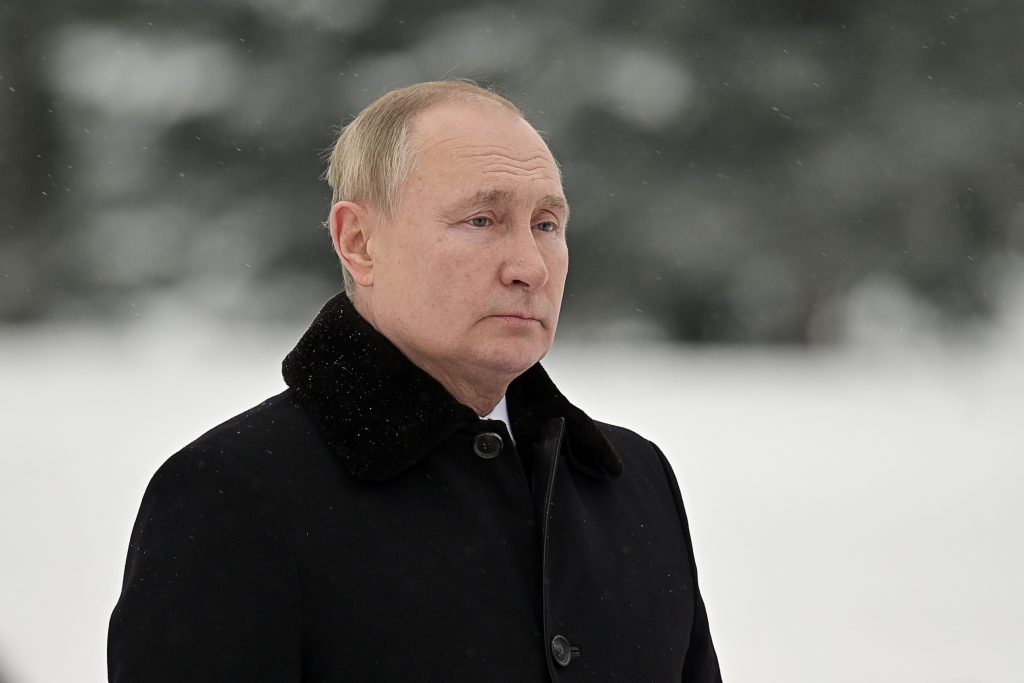
Inside Putin’s Ukraine obsession
Share this article with your network by copying this link.
By Taras Kuzio
We are currently living through what many observers regard as the most dangerous geopolitical crisis for a generation. Russia has massed a vast military force along its border with Ukraine and is threatening to unleash a full-scale invasion of the country if its demands are not met. The ensuing conflict would likely be the largest in Europe since WWII, with unclear but dire consequences for the entire continent.
At the heart of this crisis is one man’s refusal to accept the verdict of the Cold War and his burning resentment at modern Russia’s diminished standing on the global stage. Throughout his political career, Vladimir Putin has made no secret of his desire to revive Russia’s international prestige and address the perceived geopolitical injustices of the recent past. These imperial ambitions have found expression in Putin’s increasingly public obsession with Ukraine, a country whose very existence has come to embody the Russian ruler’s darkest fears and his many historical grievances.
A clear understanding of Putin’s Ukraine obsession is essential for anyone who wishes to make sense of the current crisis. Luckily, this task has been made considerably easier by the summer 2021 publication of a 5,000-word essay on the topic authored by Vladimir Putin himself…
Continue reading
DECEMBER 21, 2021 | 1:14 PM WASHINGTON, 8:14 PM KYIV
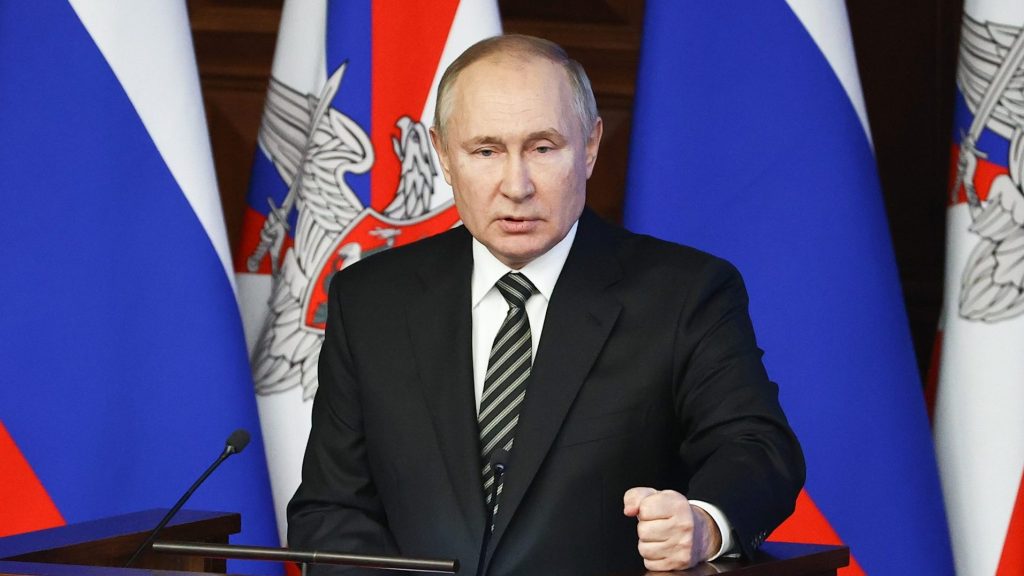
A Russian invasion of Ukraine could be Vladimir Putin’s downfall
Share this article with your network by copying this link.
By Taras Kuzio
Russian President Vladimir Putin has succeeded in attracting the world’s attention by concentrating a vast invasion force along his country’s border with Ukraine and issuing a series of ultimatums to Western leaders. For now, discussion is firmly focused on Putin’s possible plans and the international community’s ability to deter him. Is the Russian ruler really prepared to unleash a major war in the heart of Europe?
With most analysts debating potential invasion plans and possible military objectives, the likely reaction inside Russia itself has been largely overlooked. How would the Russian public respond to a major escalation in the country’s eight-year undeclared war with Ukraine? This will likely play an important role in determining Putin’s next steps, and there is good reason to believe that a full-scale invasion of Ukraine would prove highly unpopular with domestic Russian audiences…
Continue reading
DECEMBER 11, 2021 | 2:03 PM WASHINGTON, 9:03 PM KYIV
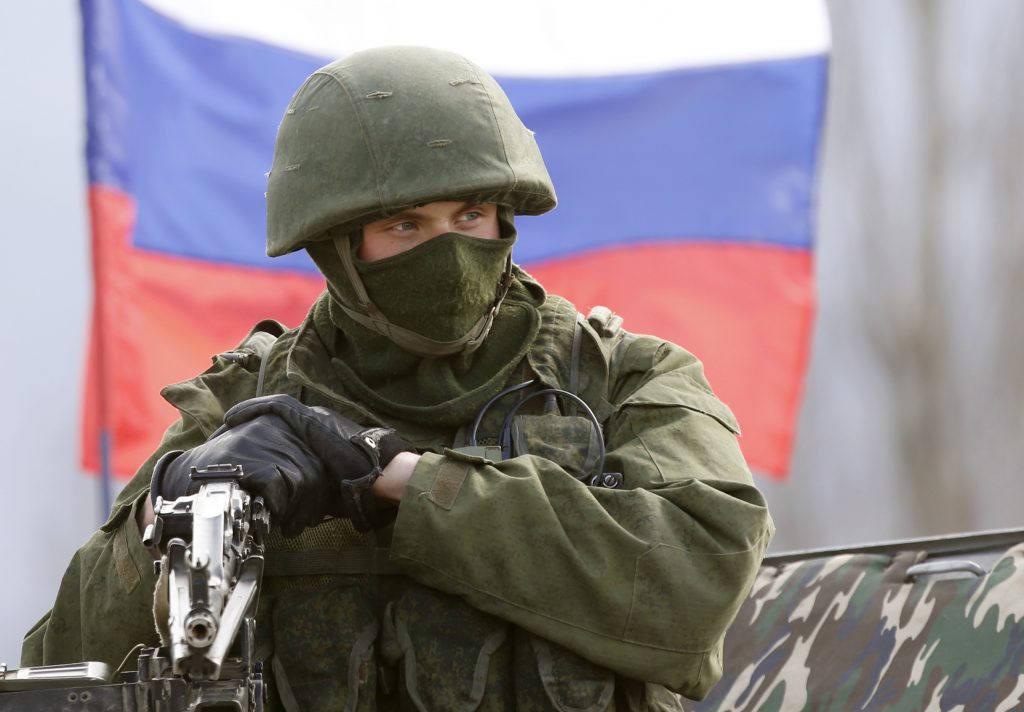
Memo to the international media: Putin has already invaded Ukraine
Share this article with your network by copying this link.
One of the more depressing features of the latest Russian military build-up on the Ukrainian border has been the proliferation of international headlines posing numerous variations of the same seemingly straightforward question: will Putin invade Ukraine?
I very much doubt that any of these headline writers are secret Russian imperialists or in the pay of the Kremlin. Even so, the question they pose is profoundly misleading and serves to underline the deadly effectiveness of Moscow’s disinformation tactics.
In reality, of course, Russia has already invaded Ukraine.
Putin himself has openly admitted to ordering the February 2014 invasion of Ukraine’s Crimean peninsula, while the Kremlin’s increasingly absurd denials have failed to prevent his subsequent invasion of eastern Ukraine from becoming the world’s worst-kept secret. Indeed, as the global media debates whether Putin may be poised to invade Ukraine, the war he launched in 2014 continues with around 7 percent of the country already under Russian occupation.
Nevertheless, as the current crisis has amply demonstrated, many international news outlets are still unsure of exactly how to characterize the war in Ukraine and remain reluctant to unequivocally identify Russia as the aggressor. Instead, coverage is dominated by euphemistic language and vague terminology that prevents audiences from understanding the full extent of Russia’s responsibility for the conflict.
This is no accident…
Continue reading
Image: A Ukrainian service member holds a machine gun in a trench at a position on the front line near the village of Travneve in Donetsk region, Ukraine on February 21, 2022. Photo via REUTERS/Gleb Garanich.
